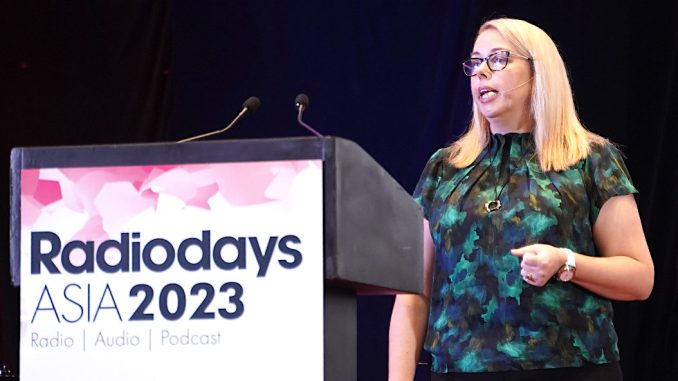
“Our radio audiences have never been stronger,” Commercial Radio Australia’s Chief Commercial Officer Jo Dick told the Radiodays Asia conference in Malaysia.
“Digital audio is not just about Spotify, not just about Radio, it’s about Audio and its never-ending evolution,” she said.
One of the huge achievements of Australian radio in the evolution of audio has been the development of the hybrid ‘Radio 360’ ratings system, which has brought a new level of confidence to agencies and advertisers about advertising on radio and podcasts, according to Jo Dick.
CRA partnered with GfK in the landmark evolution of the ratings system from paper diaries to what is now a robust digital system that combines server side raw data feeds that show listening patterns from apps and live streaming with validation by electronic diaries and watch meters.
GfK’s Deb Hishon (pictured below) joined Jo Dick in the presentation to explain how the system works.
“The industry came to us and said ‘we need to evolve audience measurement,’ they wanted to maintain the integrity of what we do, but to evolve it further, so we took the best from all the tools available and created a hybrid system which has been live since June this year.”
The Radio 360 system is made up of a combination of three measurement tools:
- 50,000 diary respondents, 80% of them using an online e-Diary and 20% still using a paper diary to reach those who cannot be reached online.
- This is added to data from 200 station server logs, balanced by using census data.
- And a national panel of 2000 people wearing a watch meter to validate the rest of the data.
What do we know now that didn’t know before?
There has been “a significant enhancement to the old system” bringing more consistency in trends, and radio companies now know a lot more about what audiences are doing.
- About one third of younger audiences are consuming commercial radio via streaming.
- The shape of the day is different for those who listen to radio via live linear broadcast platforms and those who listen via streaming. Streaming listening peaks later and stays higher throughout the day.
- Streaming is popular across all station types. Talk station listeners are streaming for longer, 6 hours and 38 mins.
- 12% of talk listeners and 14% of music listeners are streaming.
There are slightly different profiles between broadcast radio listeners and streaming radio listeners, so there is an opportunity for advertisers to create different streaming and broadcast campaigns and compare them side by side to see how effectively they can reach each audience.
The industry can now use the data to show audio consumption at a moment in time. Hishon used the example of the Queens death, showing how radio listening increased as people heard the news and wanted to find out what happened. The new system can also track summer listening, showing that the total amount of listening is similar during summer holidays as during working year, but the pattern of listening is a bit different.
The new Radio 360 ratings system is built for any market and can be adapted and scaled to any size.
Jo Dick said the new system has given Australian radio and audio “a competitive advantage, by being able to show the digital audience to agencies. Agencies are telling us they are pleased we are keeping pace with what advertisers demand.”
This story first appeared on RadioInfo.asia
